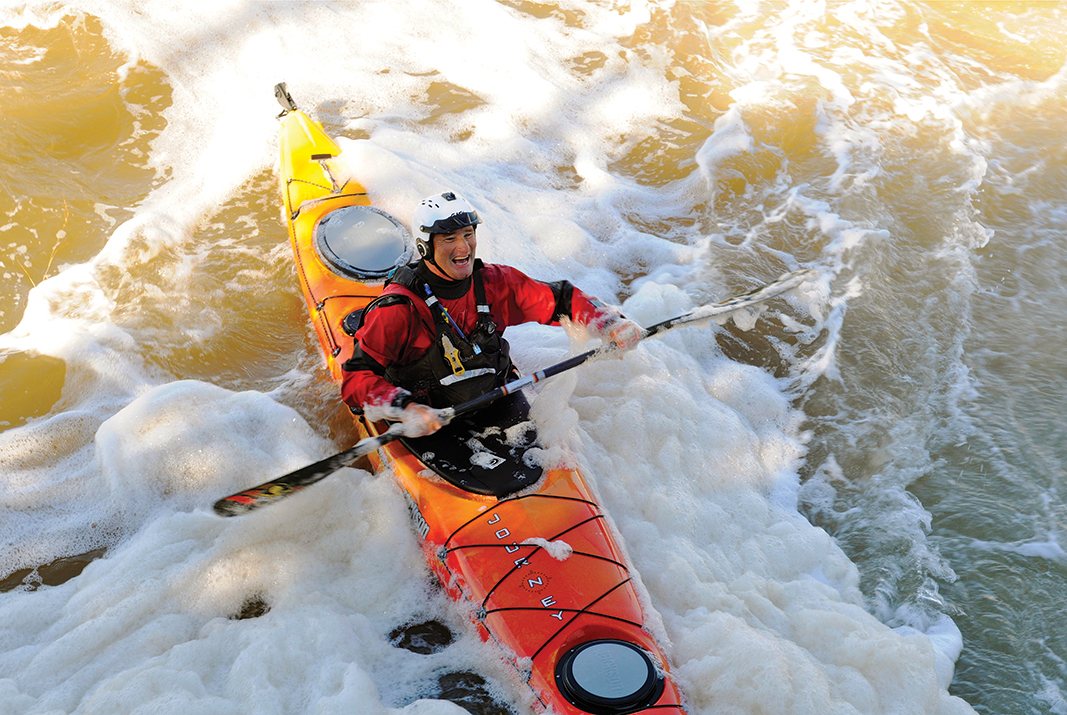Kayaks should come with warning labels.
I don’t mean the standard sort of cautionary risk disclaimer (the sort you’ll find in the masthead of Paddling Magazine):
Paddling and other activities described and illustrated herein are inherently dangerous and could result in serious bodily injury, including disability and death. Do not attempt without proper supervision, training and safety equipment…yada, yada, yada…
While it’s the head’s-up our litigious society demands, it doesn’t do much to sell the sport and, more than that, it seems kinda obvious in the way that “don’t stick a fork in an electrical outlet” and “look both ways” are by the time you’re old enough to read mouseprint.
No, I only wish someone had warned me that kayaking would take over my life. Consume my daydreams, holidays, basement, bookshelves and career. I would have started paddling sooner.
We’re used to negative advisories on things we might want to avoid: violent movies and video games, cigarettes, alcohol, profanity-strewn records, bear-plagued campgrounds. But here’s a thought—how about slapping portentous labels on good things?
Sleeping bags and pads—who needs a bed and sheets? Kayaks and canoes—I am being productive, I’m going paddling. This Buyer’s Guide—Honey, I’ve found the perfect, high-return investment for our nest egg!

Warning labels work by getting our attention and triggering psychological and emotional responses. In the case of labels on controlled substances like tobacco, a recent study by Cancer Council Victoria, in which researchers surveyed smokers in the U.S., Canada, Australia and the United Kingdom, found that larger labels that included images were most effective at capturing smokers’ attention. Simply trying not to look doesn’t help, says the study’s author, “This just goes to prove the idea that the more one tries not to think of something, the more one tends to focus on it.”
Adventure Kayak and Paddling Buyer’s Guide readers, of course, already know this. Photos of happy, adventurous kayakers plying scenic coasts trigger overwhelming urges to drop everything and go paddling.
Paddling will make you a crusader for this watery planet. Will make you care deeply about aquatic and oceanic ecology and every other environment on our bluish-greenish-brownish globe. May shift the way you think, shop, drive, dress, work and vote.
There’s another advisory we could put on boats, but maybe we should keep it under our hats for now. Paddling will make you a crusader for this watery planet. Will make you care deeply about aquatic and oceanic ecology and every other environment on our bluish-greenish-brownish globe. May shift the way you think, shop, drive, dress, work and vote. Mind-altering, life-changing stuff.
It’s no coincidence our long-time columnists and contributors often share their concern for our society’s shift out of nature and into cubicles, and the estrangement of the next generation from wild places.
So turn the pages and dive in, but don’t say I didn’t warn you. If kayaks and paddling magazines came with this “lifestyle advisory,” it might read something like this:
Attention: Kayaking is addictive and is a leading cause of good health, mental wellbeing, and meaningful relationships with friends, family and nature. Paddlers may experience cravings and emotional highs after brief exposure. Prolonged use can result in enlightenment, heightened fitness, and environmental awareness and appreciation. Enjoy!
Recirc is a column celebrating our favorite stories from 20 years of Adventure Kayak, Rapid and Canoeroots. This article first appeared in the 2016 Paddling Buyer’s Guide.
 This article originally appeared in the 2016 Paddling Buyer’s Guide issue.
This article originally appeared in the 2016 Paddling Buyer’s Guide issue.
Subscribe to Paddling Magazine and get 25 years of digital magazine archives including our legacy titles: Rapid, Adventure Kayak and Canoeroots.








